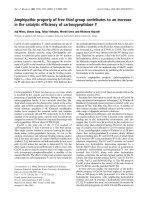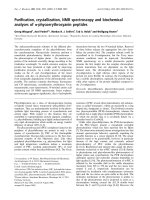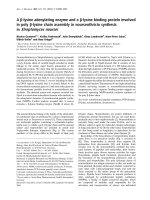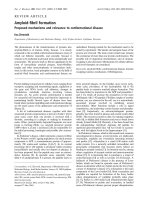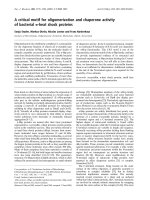Báo cáo y học: "Septic shock resuscitation: what goals and how to achieve them" potx
Bạn đang xem bản rút gọn của tài liệu. Xem và tải ngay bản đầy đủ của tài liệu tại đây (44.59 KB, 2 trang )
Available online />Page 1 of 2
(page number not for citation purposes)
Abstract
The need to achieve adequate tissue oxygen delivery early in
patients with septic shock is well established. However, it is less
well recognized that tissue hypoperfusion can exist despite
normalization of systemic hemodynamics. Efforts to resuscitate
septic patients until adequate tissue perfusion has been achieved
can potentially improve outcome. In a multicenter study, 130
patients with septic shock were resuscitated within 12 hours of
diagnosis using a protocol including goals for mean arterial and
pulmonary artery occluded pressures, urinary output, arterial pH,
and hemoglobin goals. They were then randomly assigned to
further resuscitation with either a cardiac index (≥3 l/minute per
m
2
) or a gastric mucosal pH (≥7.32) target. The intensive care unit
length of stay and 28-day mortality did not differ between groups,
but more patients in the cardiac index group were in the target
range, both at baseline and after resuscitation, as compared with
the gastric mucosal pH group. In contrast to cardiac index, gastric
mucosal pH at baseline and at 24 and 48 hours predicted
mortality. Whether other targets for the chosen variables, or
different and - in particular - earlier resuscitation efforts would have
favored one group cannot be concluded from the data provided.
The previous issue of Critical Care includes a report of a
multicenter study in which cardiac index and gastric mucosal
pH targets were compared during resuscitation of patients
with septic shock [1]. Similar to all other hemodynamic
variables with the exception of central venous oxygen
saturation, the value of a cardiac index target in the resus-
citation of patients in septic shock has not been established.
In contrast, achievement of other goals in the treatment of
septic patients (for instance, early and adequate antibiotic
treatment) has been associated with improved outcomes.
Because ‘normal’ systemic hemodynamics do not necessarily
guarantee adequate tissue oxygen supply, monitoring organ
perfusion or function may be more relevant. It has been
shown that persistent microcirculatory alterations are asso-
ciated with organ failure and mortality in patients with septic
shock [2]. Gastric mucosal pH (pHi) is an interesting
parameter that has been shown to predict outcome in many
patient groups [3,4]. However, pHi-guided resuscitation has
not improved survival rates. pHi is a composite variable that
reflects not just adequacy of local perfusion but also systemic
metabolic acid-base homeostasis and ventilation. The inter-
action of the components of pHi and their response to treat-
ment may confound the interpretation and prognostic
relevance of gastric mucosal acidosis.
In the study conducted by Palizas and coworkers [1], resus-
citation to a pHi goal was not associated with better survival
than resuscitation to a cardiac index target. Conceptually,
there are four interpretations of these findings: the tested
variables (cardiac index and pHi) are not relevant to survival;
the defined targets were not adequate; the targets were
relevant but only in combination with the achievement of other
goals; and finally, the efforts to achieve the goals were not
adequate, and the goal therefore was not achieved.
Were the tested parameters relevant for
survival?
Cardiac output determines tissue oxygen delivery and is
certainly an important variable with respect to the resolution of
septic shock. However, other variables contribute to tissue
oxygen transport, and the demands may also vary. In that sense,
as the authors state themselves [1], a goal representing a
presumed adequate relationship between oxygen delivery and
consumption (for example, mixed venous oxygen saturation)
would have been preferable. Its strong association with mortality
makes pHi an ideal target variable for improving outcomes.
Were the defined targets adequate?
In the study reported by Palizas and coworkers [1], the target
cardiac index was achieved at baseline in nearly 90% of
Commentary
Septic shock resuscitation: what goals and how to achieve
them?
Stephan M Jakob
Department of Intensive Care Medicine, University Hospital Bern (Inselspital) and University of Bern, CH-3010 Bern, Switzerland
Corresponding author: Stephan Jakob,
Published: 18 May 2009 Critical Care 2009, 13:147 (doi:10.1186/cc7870)
This article is online at />© 2009 BioMed Central Ltd
See related research by Palizas et al., />PCO
2
= carbon dioxide tension; pHi = gastric mucosal pH.
Critical Care Vol 13 No 3 Jakob
Page 2 of 2
(page number not for citation purposes)
patients. Because the mortality was 30%, it is clear that the
target should have been higher, if increasing cardiac index is
believed to be beneficial. In contrast, the incidence of low pHi
was high. However, the variable is influenced by arterial
carbon dioxide tension (P
CO
2
). It is a relatively common
practice to increase minute ventilation in order to normalize
arterial pH when bicarbonate is low. This will also increase
pHi without improving mucosal perfusion [5]. Thus, the
mucosal-arterial P
CO
2
gradient would have been a better
choice. Whether a (normal) pHi of 7.32 can be achieved at all
during the early phase of septic shock is questionable. The
use of vasoconstrictors can decrease mesenteric perfusion,
and metabolic effects of adrenaline (epinephrine) may
increase P
CO
2
further.
Were other important targets achieved?
There is no information on how other aspects of septic shock
treatment were addressed (antibiotics, source control,
ventilator settings, and so on). This information would have
enhanced ability to interpret the study findings.
Were the measures to achieve the goals
adequate and the goals achieved?
Again, too few data are presented to answer this question.
The authors indicate that crystalloids and colloids were given,
but in their protocol only saline is listed. Although colloids can
be harmful in sepsis [6], normal saline (or colloids in saline)
can cause hyperchloremic metabolic acidosis and thereby
decrease mucosal pHi. Adrenaline (epinephrine), noradrena-
line (norepinephrine), dopamine, and dobutamine were used
to improve blood pressure and flow. Although adrenaline can
impair splanchnic perfusion in septic shock [7,8], dobutamine
appears to be able to reverse these changes, at least in part
[9]. Dopamine can decrease splanchnic metabolic activity in
patients with sepsis [10,11]. pHi was measured every
6 hours, and no data are given on the frequency of cardiac
index assessments. Four daily assessments of the treatment’s
influence on the target variable may be too few, especially in
view of the fact that splanchnic blood flow is highly variable in
septic patients [12]. There was no increase in cardiac output
or pHi over the 48-hour observation period.
It would have been interesting to see how the individual
therapeutic interventions influenced the target variables.
Without this information, the adequacy of the treatment
cannot be determined. Nevertheless, the work by Palizas and
coworkers [1] reminds us that mucosal acidosis persists in
the majority of patients who ultimately will die after resusci-
tation from septic shock. Monitoring and treating tissue hypo-
perfusion therefore remains an option to improve outcome.
Competing interests
The Department of Intensive Care Medicine at Inselspital has
or has had research contracts and/or collaboration contracts
with Edwards Lifescience, GE Healthcare, Pulsion, Orion
Pharma, Berna Biotech and B. Braun Medical.
References
1. Palizas F, Dubin A, Regueira T, Bruhn A, Knobel E, Lazzeri S,
Baredes N, Hernández G: Gastric tonometry versus cardiac
index as resuscitation goals in septic shock: a multicenter,
randomized, controlled trial. Crit Care 2009, 13:R44.
2. Sakr Y, Dubois MJ, De Backer D, Creteur J, Vincent JL: Persis-
tent microcirculatory alterations are associated with organ
failure and death in patients with septic shock. Crit Care Med
2004, 32:1963-1964.
3. Theodoropoulos G, Lloyd LR, Cousins G, Pieper D: Intraopera-
tive and early postoperative gastric intramucosal pH predicts
morbidity and mortality after major abdominal surgery. Am
Surg 2001, 67:303-308.
4. Maynard N, Bihari D, Beale R, Smithies M, Baldock G, Mason R,
McColl I: Assessment of splanchnic oxygenation by gastric
tonometry in patients with acute circulatory failure. JAMA
1993, 270:1203-1210.
5. Jakob SM, Parviainen I, Ruokonen E, Kogan A, Takala J: Tonome-
try revisited: perfusion-related, metabolic, and respiratory
components of gastric mucosal acidosis in acute cardiorespi-
ratory failure. Shock 2008, 29:543-548.
6. Brunkhorst FM, Engel C, Bloos F, Meier-Hellmann A, Ragaller M,
Weiler N, Moerer O, Gruendling M, Oppert M, Grond S, Olthoff
D, Jaschinski U, John S, Rossaint R, Welte T, Schaefer M, Kern P,
Kuhnt E, Kiehntopf M, Hartog C, Natanson C, Loeffler M, Reinhart
K; German Competence Network Sepsis (SepNet): Intensive
insulin therapy and pentastarch resuscitation in severe
sepsis. N Engl J Med 2008, 358:125-139.
7. De Backer D, Creteur J, Silva E, Vincent JL: Effects of dopamine,
norepinephrine, and epinephrine on the splanchnic circula-
tion in septic shock: which is best? Crit Care Med 2003, 31:
1659-1667.
8. Levy B, Bollaert PE, Charpentier C, Nace L, Audibert G, Bauer P,
Nabet P, Larcan A: Comparison of norepinephrine and dobuta-
mine to epinephrine for hemodynamics, lactate metabolism,
and gastric tonometric variables in septic shock: a prospec-
tive, randomized study. Intensive Care Med 1997, 23:282-287.
9. Levy B, Bollaert PE, Lucchelli JP, Sadoune LO, Nace L, Larcan A:
Dobutamine improves the adequacy of gastric mucosal per-
fusion in epinephrine-treated septic shock. Crit Care Med
1997, 25:1649-1654.
10. Guérin JP, Levraut J, Samat-Long C, Leverve X, Grimaud D, Ichai
C: Effects of dopamine and norepinephrine on systemic and
hepatosplanchnic hemodynamics, oxygen exchange, and
energy balance in vasoplegic septic patients. Shock 2005, 23:
18-24.
11. Jakob SM, Ruokonen E, Takala J: Effects of dopamine on sys-
temic and regional blood flow and metabolism in septic and
cardiac surgery patients. Shock 2002, 18:8-13.
12. Sakka SG, Reinhart K, Wegscheider K, Meier-Hellmann A: Vari-
ability of splanchnic blood flow in patients with sepsis. Inten-
sive Care Med 2001, 27:1281-1287.





